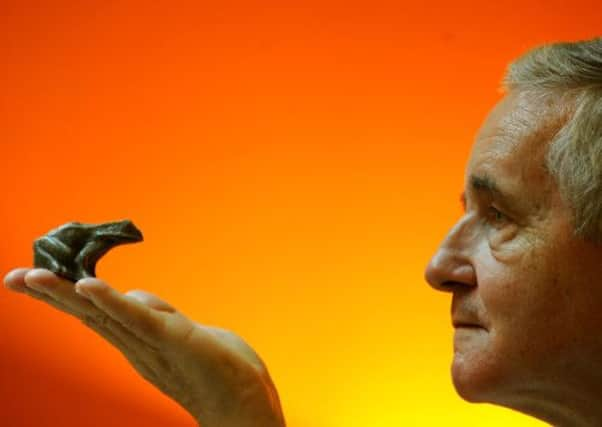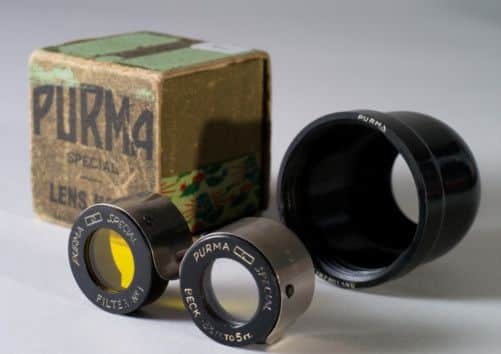An object lesson


To set the tone for a slightly bizarre morning, Graham Chesters and I are standing on Hull station and looking at the graceful, balletic statue of Philip Larkin, poet, librarian and icon of provincial melancholy.
Did you know, says Chesters, that three pairs of Larkin’s spectacles are on display at the Eye Hospital? “It’s only about seven minutes’ walk,” he says. “But you probably won’t have time.” I think: I probably will have time.
Advertisement
Hide AdAdvertisement
Hide AdChesters, vice chairman of the Philip Larkin Society, leads the way into the Mercure Hull Royal Hotel, which, in its days as the Royal Station Hotel, was a favourite of Larkin’s. The silence one Friday night in 1966, he famously wrote, was “laid like carpet”. Watched by two bemused elderly couples having lunch, Chesters delves in a carrier bag and unwraps half-a-dozen parcels swathed in tissue paper. For anyone with even the slightest interest in Larkin, it’s like Christmas Day.


Here is the poet’s puncture repair kit, here’s his shaving mirror, his boyhood albums of cigarette cards, an ashtray, a book of matches, a model frog, a Peter Rabbit ornament. Together with his mortar board, his Anglepoise lamp, his typewriter, his umbrella, his corkscrew and a range of his ties (some stained), they’ve inspired Larkin in 25 Objects, a photographic exhibition which opened this week at Hull Central Library.
The objects – like a saint’s holy relics – were discovered by James Booth, the Larkin Society’s literary adviser and author of a forthcoming biography of the poet. Sitting in a winged armchair, he needs little encouragement to outline the poignant story of Monica Jones, Larkin’s long-term companion, who moved into his home in suburban Hull in 1983, two years before he died.
“She stayed there in the house for the next 15 years as a virtual recluse,” says Booth. “She watched wrestling, cricket and literary programmes on television, but when I interviewed her in 1999, two years before she died, she was basically bedridden. She was always a very feisty, rather anti-social person and pretty violently right-wing, but she was very helpful to me.”
Advertisement
Hide AdAdvertisement
Hide AdMonica preserved the house, which many believe stifled Larkin’s creativity, as it was when he was alive; his clothes remained in a wardrobe, his shoes in a cupboard, his books and records untouched; it was like a shrine.
After her death, Booth, former Professor of English at Hull University, joined fellow enthusiasts to explore the house. They discovered that the poet, an archivist by instinct, rarely threw anything away.
“He had kept his father’s long johns, with the laundry label in it, and his own long johns from when he was a boy.
“We were looking for evocative, Larkinesque stuff and we thought at first that the bumps under the carpet might be manuscripts, but they were just little mountain ranges of dust.
Advertisement
Hide AdAdvertisement
Hide Ad“What we saw was his final years. His last significant poem was from 1979; the spark had gone. It was very depressing to think of those final years when he wasn’t writing, followed by 15 years of Monica nursing the flame, cut off in a lonely world.”
Booth and his colleagues salvaged some 500 objects, including 123 ties – some still in cellophane wrappers – and Monica’s 1960s Sophia-Loren-style sunglasses. Their archive, now housed at the Hull History Centre, is the basis of the new exhibition. Photographer Dennis Low was commissioned to document the objects, including some of Larkin’s suits – “really big – big jackets with big pockets”. But, rather than just turn out standard “record shots”, he has brought considerable creativity and imagination to the project. The puncture repair kit, for instance, looks startlingly surreal when blown up into a large-scale, brightly coloured still life: a plastic box, chalks and a well-squeezed tube of vulcanising fluid (“Warning – vapor harmful”).
“Handling these intimate objects was very strange,” says Low, who was photographer-in-residence at Hull’s hugely successful Larkin 25 festival three years ago and lives in Chichester, not far from the Arundel tomb that inspired one of Larkin’s most famous poems. “It was a little bit creepy to be presented with a person’s slippers and to be making decisions about how to photograph them. And I didn’t really want to touch his hearing aid too much – something that had been in the guy’s ear.
“Some of these things could have belonged to anyone. I photographed a blank notebook, but it was Larkin’s blank notebook, it was his shaving mirror, his pencils. And Larkin was so fixated by objects himself. He gave them such weight in his poems.”
Advertisement
Hide AdAdvertisement
Hide AdThe 25 photographs in the exhibition were chosen jointly by James Booth and Graham Chesters, Emeritus Professor of French at Hull University. They aimed to reflect various aspects of the poet’s life: his writing, his love of photography, cycling and cricket. The model frog recalls his poems about the “old toad”, as he called work (“He didn’t make much distinction between frogs and toads,” says Booth); the glass ashtray marks his lifelong addiction to cigarettes; the Peter Rabbit ornament recalls how Larkin and Monica shared an intimate Beatrix Potter-like language: he addressed her as “Forepaws”, “Ears” or “Bun”. Booth’s commentary on the pictures offers plenty of insights into Larkin’s life. In the 1960s, for instance, he stopped signing fine notices at the university library “when he realised that students were offending simply in order to obtain his signature”.
“He was a man of many different interests but was basically a sympathetic and humane individual who loved the commonplace,” says Booth. “All the people who knew him say he was a charming, entertaining person; he would lead the conga round the library shelves at parties.”
As do his spectacles. Seven minutes’ walk from the station – Chesters was spot-on – the bright new Hull and East Yorkshire Eye Hospital has a display of three pairs of them, with cases and cleaning cloths, from different periods, on loan from the Larkin Society.
There’s a pair of round, owlish ones from the 1940s, a delicate gold pair from the 1950s and a later pair with heavy black frames and arrestingly thick lenses. Alongside is the poem Long Sight in Age, neatly laid out like an optician’s chart, together with the spectacles’ prescriptions. Less than one per cent of people are apparently as short-sighted as Larkin.He was photographed wearing the heavy black spectacles in 1974, but reckoned the pictures made him look like the Boston Strangler.
Larkin in 25 Objects is at Hull Central Library until September 19.